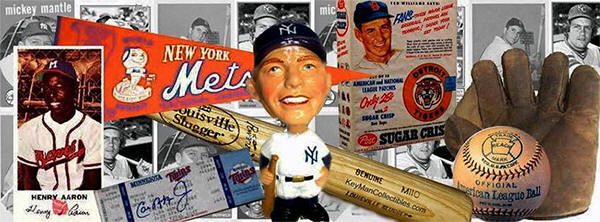The first baseball gloves
were created in the 1870's with the
idea to pad and protect the
players' hands. Most were designed
so the player could knock the ball
to the ground and not necessarily
catch it. The first players to use
baseball gloves were often taunted
and teased as being "too soft" or
"sissies" because they did not want
to catch the ball with their bare
hands. This mentality slowed the
development of baseball glove
design.
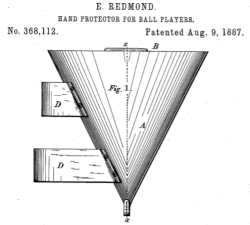
History's first baseball gloves
were made from pieces of leather
sewn together to fit over a
player's hand. Many early baseball
gloves were simple leather gloves
with the fingertips cut off.
Workman gloves were readily
available and commonly refashioned
for use. The growing
popularity of the use of baseball
gloves opened the door for the
retail market, and soon patented
designs began to surface,
regardless of practicability.
1887
Ball Player Hand Protector.
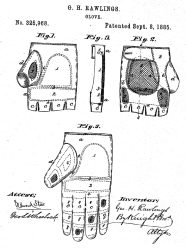
In the 1880s a rule was passed that
made even the most "manly" of
players consider using gloves:
pitchers were now allowed to throw
overhand. With the speed of pitches
now greatly increased, balls were
being thrown with alarming force to
catchers, and struck with much
greater force by batters. In 1885,
George H. Rawlings was issued a
patent for a
Padded Baseball Glove.
This was the first patent that was
specific to baseball. Previous
patents with suggested use for
"sports" were developed by Spalding
and Reach for use on the baseball
field.
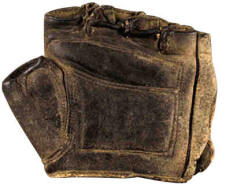
Rawlings patent featured a padded
glove in both fingerless and full
fingered models. The gloves with
the fingertips cut off, were made
to allow for the same control of a
bare hand when throwing but with
extra padding.
"Finger Tip" gloves, with heavy
reinforced leather along the tip of
the fingers were soon to follow.
They were designed to help grip a
caught ball from getting away, and
add extra protection to the finger
tips The padded "Workman" style
baseball gloves would be the model
used
for years to come.
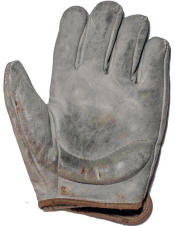
The workman style
Crescent Padded Palm or heel
ridge gloves would become popular
from about 1897 to 1905. A ridge of
rolled padding extends in a
semicircle from the thumb across
the wrist and up towards the pinky
finger. The ridge creates a deep
pocket to trap the ball. Sometime
around 1900 the Crescent gloves
were also made available with a
full web. The first web using a
piece of material sewn directly to
the thumb and forefinger. By 1910
the crescent pads are pretty much
phased out, showing up occasionally
in the teens.
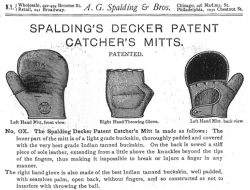
Earl Harry Decker, a catcher that
played Major League baseball from
1887-1890, held a number of patents
that are popular with collectors
today. The most popular being the
1889 patented "Decker's Safety
Mitt," AKA the "Decker Patent."
Among the multiple features the
mitt featured an extra layer of
leather on the back, and edge band
on top of the finger stalls for
protection of the catchers fingers.
Decker sold the patent to A.G.
Spalding and this design was used
for many decades to come.
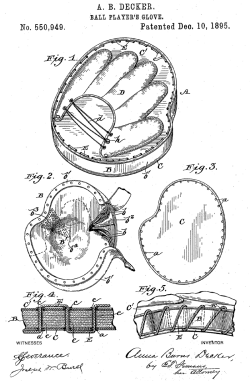
Because Harry was in trouble with the law, his wife Anna Burns Decker
submit a patent for him in 1895.
The patent was to produce a cheap construction of
a glove or mitt, containing a
relatively greater catching
surface, independent inside padding
which can be readily detached and
replaced, and full round perimeter
banding.
Harry Decker invented a thumbless design and filed the patent in 1904
while incarcerated at San Quentin.
One of the prison guards, George J
Stiteley, did the
legal paperwork and was credited as
a co-inventor. convicted of
numerous crimes with most involving
forgery, Decker racked up arrests
and convictions in at least six
states. Victims of his crimes
included Al Reach, whose name
appeared on forged checks.
The "King Patent" with the removable lining was patented by Spalding
assignee Charles M King on June 28,
1910. The inner lining padding can
be removed from the edges of the
wrist and back portions of the
glove, for adjustment and repair.
Advertised as a glove within a
glove, it can be easily taken apart
and put together again. Just as
much or a little padding as the
individual may desire can be
stitched to the fabric of the inner
glove. Extra padding for stitching
on was made available at any A.G.
Spalding store.
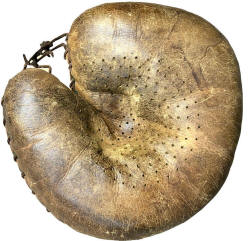
Spalding introduced the No. 10-0
"World Series" Catchers mitt in
1913. The mitt featured a molded
face, patented by assignee Charles
M. King. Also made
available in the 1913 catalog was
the model No. 10-0P catchers mitt
that featured an additional King
patent.
The perforated palm. The
object of the perforated palm,
patent no. 1,056,909 was "to
produce a base ball glove or mitt
in which the palm portion is
constructed to present a more
adherent surface in catching a base
ball." Reach issued the 9A
Perforated Palm catchers mitt
around the same time.
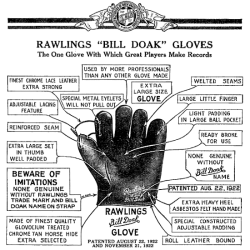
The largest improvement ever in
glove design happened in 1920, when
Bill Doak, a journeyman pitcher for
the St. Louis Cardinals, approached
Rawlings with an idea for a web
laced between the first finger and
thumb. Before Doak's invention,
gloves were primarily protective
equipment that kept fielders' hands
and fingers from being hurt by hard
hit balls. Bill Doak developed the
idea of putting a substantial
webbing between the glove's thumb
and first finger to form a
substantial pre-formed pocket in
which to catch the ball.
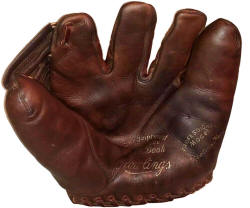 The
Rawlings "Bill Doak" model
The
Rawlings "Bill Doak" model that
was first introduced in 1922 was so
revolutionary that it remained
available until 1952 with only
minor modifications, and variations
with the pattern. Models include;
the Improved Bill Doak which was
issued in 1931, Doak Kenworthy
model in 1932, Model J in 1932, H3
3F three finger model in 1934,
model H in 1942, and model 5BD in
1945. Doak's invention was the
ancestor of all modern gloves.
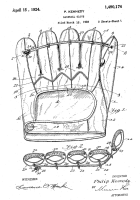
In
1923, Philip Kennedy of the Kennedy
brothers, owners of the Ken-Wel
Sporting Goods Co., filed for a
patent, that would connect the
fingers with lace. The main
objective of the interlaced fingers
was to create a deep pocket that
would close around the ball when it
hit the palm, and prevent the
fingers from bending back from the
speed of the ball, or spreading
apart allowing the ball to get
away. This new design was
advertised to help prevent errors.
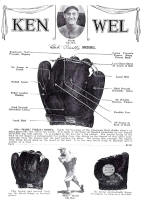
The
first Ken-Wel model was endorsed by
"Crack 3rd baseman of the
Cincinnati Reds" Babe Pinelli. The
glove featured leather tabs on the
back of the fingers in which the
lace ran though.
The Dazzy Vance
model followed the following year
and became a mainstay in the Ken-Wel
catalog into the 1940's. Sometime
around 1934 eyelets in the fingers
replaced the outer leather tabs.
There were a number of feature
variations through the years, that
encluded a 3 finger model, and by
1940 a double tunnel web was added.
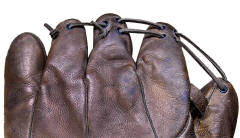
Other
companies also experimented with
variations of the interlaced finger
design, Goldsmith, Reach, Nocona...
but all other glove models in the
market were manufactured with split fingers,
including the Ken-Wel catalog. This
glove design did last through the
1940's, but it wasn't until the
1950's when laced fingers took hold ending
the era of the split finger
baseball glove.
You cannot have a discussion about innovative baseball glove design
without dropping the name of
Rawlings "Glove Doctor," Harry
Latina. Assignee to Rawlings Latina
took out some 30 patents for
features such as adjustable thumb
and pinky loops, the V-anchored
web, and the “Edge-u-cated” heel.
He designed such models as the
Deep Well Pocket (1930), Trapper
(1940), and V-Anchored Web (1950).
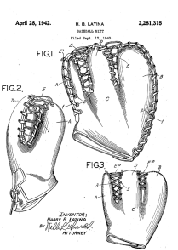
In
1939 Hank Greenberg's oversized
first base mitt was the source
of worry, and protest that led to
Rule 21 (size & weight of gloves)
to be rewritten that same year.
Landis did not want the gloves to
resemble a birds nest or a
"lacrosse racquet." Interlocking
fishnet type webbing was out. It
was a fortuitous time for Latina.
By 1940 he revolutionized the base
mitt with his "Trapper" design,
replacing the older "Oven Mitt"
style.
In 1940 Rawlings and Latina filed for a patent that was granted in 1942.
The main object of Latina's
invention was to provide a baseball
mitt, which is of such design or
construction that when it is
subjected to the pressure of a
caught ball, will automatically
close around the ball, effectively
"Trap" it. A design that also
complies with the rules,
regulations and requirements
pertaining to such devices, and
which has a ball back-stop that is
more efficient than those employed
in mitts of conventional design.
The "Trapper model" is born.
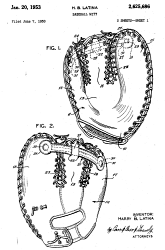
The glove was a hit with players however there was concern that the lacing
could be loosened up to make the
web bigger than the dimensions in
the rule book for a legal glove. In
1950 modifications were made and a
patent was applied for to place a
"web controller" strap at the top
of the web. That way, no matter how
much you loosened up the laces, the
web could only get as wide as the
web controller, maintaining the
legal distance between the thumb
and forefinger.

